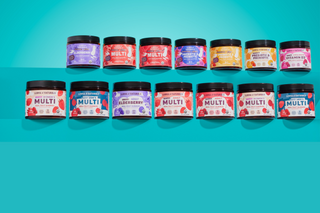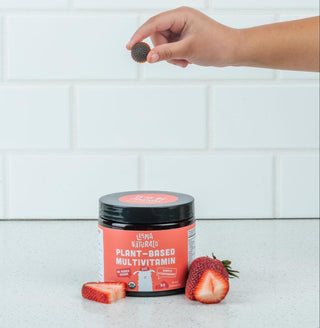
Key Points:
- Zinc is a critical trace mineral that your child needs to stay healthy.
- Zinc supports many functions in your little one’s body, including healthy growth, development, and immune function.
- If your child is eating a healthy and varied diet, they may be getting enough zinc.
- However, even a mild deficiency in zinc for kids can have serious effects on their health. If you’re worried, consult your doctor to find out they need a zinc supplement.
While only about 12% of the U.S. population likely has a risk of zinc deficiency, even a mild deficiency can affect your child’s physical and mental health. So it’s important to understand the role of zinc for kids and what you can do to make sure they get enough of this essential nutrient.
Let’s explore what zinc is and why it’s so important. We’ll also look at how much zinc your child needs, what signs may indicate a deficiency, and how to increase their zinc intake. After all, your child’s health is precious — and it sets the stage for a healthy adulthood.
The Benefits of Zinc for Kids
Zinc is an essential nutrient your child needs for overall wellness. It’s a trace mineral, which means it’s only needed in small doses. As the human body can’t make it and doesn’t store it, your little one needs a certain amount of zinc every day.
Zinc for kids is critical for many functions. It supports:
- Normal growth and development (a deficiency can lead to stunted growth)
- Production of the protein and DNA in cells
- Enzyme functions in the intestine and liver
- Innate and adaptive immune function
- Wound healing
- Digestive and metabolic health
- Healthy brain growth, as well as cognitive function, memory, and attention
- Healthy skin, hair, and nails
- Reduced cell damage caused by free radicals (zinc is an antioxidant)
- Healthy sexual development
- The senses of taste and smell
- Balanced blood sugar
- Strong teeth and bones
- Absorption of vitamin A
How Much Zinc Does Your Child Need?
The amount of zinc your child needs depends on their age. According to the National Institutes of Health, recommended dietary allowances (RDA) of zinc for kids who are not vegan or vegetarian (more on this below) are as follows:
- 0-6 months: 2 milligrams
- 7-12 months: 3 milligrams
- 1-3 years of age: 3 milligrams
- 4-8 years of age: 5 milligrams
- 9-13 years of age: 8 milligrams
- 14-18 years of age: 9 milligrams for girls and 11 milligrams for boys
While many plant-based sources do contain zinc, they also contain phytates, which bind zinc and therefore reduce zinc absorption. So if your child’s zinc intake comes mainly from plant-based foods, they probably need at least 50% more to meet their daily zinc requirements. For example, if your 15-year-old daughter is vegan, she should aim to get 13.5 milligrams of plant-based zinc per day.
Some other ways to reduce the impact of phytates on zinc absorption from plant-based sources are to soak, ferment, or heat the food, among other methods. Also, some plants — like garlic and onion — act as mineral absorption enhancers, and cooking your food with them can enhance zinc absorption by as much as 50%.
Signs of Zinc Deficiency

If your child isn’t getting enough zinc, you may see some of these signs:
- Frequent colds and infections due to a weakened immune system
- Diarrhea
- Loss of appetite
- Rashes
- Sores on the skin or in the eyes
- Hair loss
- Slow or stunted growth
- Slow wound healing
- Short attention span
- Learning difficulties
- Poor memory
Adolescents are at particular risk of zinc deficiency, as they are going through rapid growth and often don’t focus on healthy eating.
Of course, there may also be other reasons for these symptoms, so if you notice any of them, your first port of call should be your doctor or pediatrician.
Important notes:
- There are some health conditions and other circumstances in which your child may need more zinc than usual, for example, if they have diabetes, celiac disease, or Down syndrome or are going through a very stressful or traumatic period.
- Zinc also interacts with some other medications, including antibiotics.
So if your little one is suffering from any health condition, it’s especially important to consult your pediatrician or another professional healthcare practitioner.
Whole Food Sources of Zinc for Kids

Breast milk naturally contains zinc along with an enzyme that helps your baby to absorb it. If you’re breastfeeding, your little one won’t usually need extra zinc for their first six months. After that, they should get extra zinc from whole foods like peas and beans. Infant formulas also contain enough zinc for your little one, so can help support their zinc intake.
Once your little one is on solid foods, these are good sources of zinc for kids:
- Legumes, like chickpeas, beans, and lentils
- Soy products, like tofu and tempeh
- Nuts, like almonds, walnuts, and cashew nuts
- Seeds, like pumpkin, hemp, flax, and chia seeds
- Wheat germ
- Yeast
- Molasses
- Whole grains, like brown rice, quinoa, and whole-wheat bread
- Potatoes with skin on
If your child is eating a regular, healthy diet that includes plenty of zinc-rich whole foods, they may well be getting enough zinc. If, however, you have a picky eater, a vegetarian or vegan, or an adolescent on your hands, or your little one has an underlying health condition, they may need a zinc supplement. Consult your doctor to check on this.
Zinc Supplements for Kids

Zinc supplements are available in different forms, including liquid, tablets, and gummies. They contain different types of zinc, with chelated forms being the best for absorption. While there are many forms of chelated zinc supplements, some include zinc orotate, zinc citrate, zinc gluconate, zinc picolinate, and zinc acetate. Note that zinc supplements should be taken with food, or your little one may end up with an upset stomach.
Zinc for kids is also found in many kids’ multivitamin supplements alongside other important nutrients like vitamin C, vitamin D, calcium, magnesium, omega-3s, and sometimes even with prebiotics and probiotics. It’s also often included in immune support supplements, like Llama Naturals’ Whole Foods Elderberry Gummies for Kids, which includes a zinc chelate made with full-spectrum amino acids for optimal absorption.
When buying zinc for kids, check how much zinc is in the supplement — this is usually written as “mg of zinc.” Also, make sure you read the dosage instructions carefully.
Side Effects of Zinc for Kids
Too much zinc for kids can lead to toxicity. While this is unlikely if they are only eating whole foods, it can happen if you give them too high a dose of supplements. Look out for symptoms like nausea, stomach cramps, diarrhea, vomiting, headaches, and poor memory or motor skills.
Too much zinc can also lead to copper deficiency, as zinc competes with copper for absorption. Your child needs copper for energy and a healthy cardiovascular system, amongst other things.
Zinc for Kids Supports Your Child’s Health

Zinc is important for many different functions in your child’s body, including normal growth and development, immune function, cognitive ability, and digestive health. If your child is eating well, there’s a good chance they’re getting enough zinc. But if they aren’t, they may have a zinc deficiency.
If that’s the case, consult your doctor or pediatrician to find out if they need a zinc supplement, either on its own or in combination with other high-quality supplements. Zinc for kids can go a long way towards supporting their overall health and wellbeing and set them up for their best life in the future.
Llama Naturals is a plant-based nutrition brand that has created the World's First Whole Fruit Gummy Vitamins that are made with no added sugar and whole-food vitamins. They are USDA Organic, Vegan, Gluten Free, free of common allergens, and are slow-cooked on low heat to retain rich phytonutrients & fruit flavor. It’s a win-win gummy vitamin that the whole family will love.







